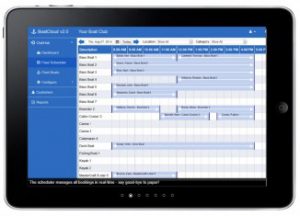We get to the end of chapter 3 with sections on Publicity and promotion, the training plan for the course and foul-weather alternative training plans.
12. Publicity and Promotion
1. Information Poster
Unless you are very fortunate and have a waiting list to join your club, work is needed to publicise your learn to scull / row course in advance in order to encourage athletes to attend.
Start by writing a short statement about what you are offering. Make sure you answer the questions “What, when, where, how to join”. This should be around 250 – 300 words long and should include a headline, a website address for information and a contact telephone number.
Then re-draft it in a longer form. Up to 1000 words including more detailed information including the venue, price for attendees, how to join, what is included in the fee (tuition, food, equipment), what attendees will have learnt on the course and any other information that you think will encourage people to attend.
Try to find some photographs of people rowing from your club or of a previous course that you’ve run. It helps if these are digital.
You now have all the raw materials to draw up a poster and a detailed information sheet. If you have access to a graphic artist ask them to design a one-page poster and a two-sided information sheet that includes the poster information. If not, just use a word-processing programme to write it out. Use bold, large fonts for headlines and colour if you have a colour printer.
2. Signing up attendees
Most people have access to the internet and so using a service to get people signed up and collecting their contact details will save you a lot of time. There are a range of services available including Eventbrite and Iris. Most offer a free service for events that do not charge attendees. But we are charging, I hear you say! Fear not. When these organisations collect money for you they charge for use. Therefore, say that your event is free and collect the money in person when people come to your course on the first day.
When setting up the joining form, consider what information you would like to have about each attendee. Usually this includes telephone and email address, experience level and (as a bit of market research) you might ask how they heard about the course.
Sample information: [see section on Organisation and the list of what to bring]
The sign-up service will give you a unique web address URL for your event. Copy this and add it to the event information poster. If it is a very long string URL, you can shorten it using a service like Tinyurl.com. On their site you can let them shorten it to a string of letters and number or choose a custom address like www.tinyurl.com/RobRoySculling that readers may find easier to remember.
3. Spreading the word
Send the poster, information sheet and sign up URL to the club website webmaster and ask them to put them up on the club website. You can ask them for a prominent mention on the home page and also to put them onto events or news pages (if you have them). Suggest that the poster and information sheet be available both as a download pdf document as well as reproduced in full. Giving readers the option to print information and also take a copy of it in a form that they can email to a friend may get you more attendees.
When they are up on the website, use the club email group lists to tell every member about the learn to scull / row course and ask them to send the information round to any friends who may want to join.
4. Other places to spread the word
First use local resources then rowing organisations to help you promote the course.
• Send your poster and information sheet and the club website URL with the detailed course information to the local newspaper and ask them to write an article about it. They will be grateful for your digital photographs too.
• Contact the local council sports and recreation department and ask them where you can publicise the course. Many have email newsletters and can send it out to their email list of local sporting and community organisations.
• Visit the local library and ask them if you can put up a poster on their noticeboard (have it ready printed when you visit).
• Call local secondary schools and ask them if they will put up your poster
• Ask club members if they can put up a poster at their workplace or get it included in internal newsletters
Rowing is a well-connected sport and there are several excellent websites where you can publicise the course. Remember, that these are more likely to recruit people who are already rowers and scullers than complete beginners.
• In the UK the New Rowing Information Page – use the form to send her information. Include the link to your website page where the detailed information is published. In the US row2k.com may also be able to assist.
• The UK Amateur Rowing Association has a club news page where they will publish information. Send it to [email@ara-rowing.co.uk]. In other countries the national rowing federation may have a similar service.
• Rowing and Regatta Magazine may help you publicise in their news pages. Remember, they publish monthly and the copy deadlines are usually 3 weeks before publication date. Don’t be disappointed if they do not have space for your news.
• Web forums like talkrowing.com, rowingillustrated.com and coxie.com or coxswainnation.com may be useful. Browse the forum categories carefully before deciding to post. Some are un-moderated and include a lot of negative and some abusive comments and you may prefer not to use these.
• Rowing bloggers write about a range of sport-related topics and if you read blogs regularly you may feel that their audience will be a good one for your event.
As a last option, you may consider paying for advertising. Some of the larger rowing courses and those run by professional organisations pay for print adverts in the rowing magazines or in the ‘classified’ section of text-only adverts that usually appears at the back of the journal. Beware the cost of producing artwork ready for print plus the advertising space (which will carry VAT sales tax on top of the price they quote you) may be too much for most club budgets. There is no guarantee paid advertising will bring in customers.
13. Training Plan
Onto more exciting things, a training programme for your camp. The purpose of attending a learn to scull / row course is to progress your skills so you know more and are more skilful at the end than you did at the beginning. Your training programme needs to reflect this.
It is also helpful for every coach to be teaching the same things on the same day of the course. Individual athletes may need particular technical points but by all following the same daily “focus” you develop a commonality through all attendees and coaches.
The starting point is to know the current skill level of your attendees. If none have sculled or rowed before then it’s easy – everyone is at the same level of zero skill. It becomes more complex when you have a range of skills.
When attendees sign up to join the course, it may be helpful to ask them what their skill levels are. Keep it simple – beginner, intermediate and advanced. And maybe suggest what each level represents:
– Beginner – I have done a very little sculling or rowing
– Intermediate – I can safely take a single scull for a 2000m distance or I have rowed an 8 in a regatta
– Advanced – I have won regattas in sculling or rowing
I think that using regatta entry rather than UK ARA Points is a better reflection of likely skill. You have got to have done quite a lot of rowing or sculling before entering a regatta or winning one.
Beginners’ training programme
Using the UK Level 2 Coaching certificate book as a base is a very good starting point for writing a training programme for complete beginners.
Day 1 – Parts of a boat, carrying a boat, how to hold an oar / scull, squaring and feathering, put a boat on the water and get in and out safely, static boat balance confidence exercises, the safe position. [may also include ergo work to demonstrate on land]
Day 2 – Review day 1, get the boat onto the water and get in and out twice. Static boat balance confidence exercises. Check everyone has remembered correctly.
Sculling in a single – take strokes with one oar at a time so the boat ‘fish-tails’ as it moves leaving the other scull flat on the water in the safe position. Add increasing slide and leg drive as confidence builds. Turning the boat round and looking round from the safe position for course corrections.
Sculling a crew boat – square blade paddling individually and in pairs, feathering, turning the boat round, learning commands and seat numbers.
Rowing a crew boat – square blade paddling individually and in pairs, feathering, turning the boat round, learning commands and seat numbers.
Day 3 – Review day 2, focus on correctly holding the oar / scull handle while squaring and feathering.
Sculling in a single – Practice handle grip squared / feathered while stationery in the safe position. Progress to sculling with both sculls simultaneously at arms / body only and add increasing slide and leg drive as confidence builds. Holding up the boat and stopping quickly.
Sculling a crew boat –
Rowing a crew boat –
Day 4 – Review day 3,
Sculling in a single – Identify the correct handle/hand positions at the finish (high elbows, flat wrists) and at hands away (left hand leading right and knuckles of right hand under thumb of left). Practice pausing at the hands away (safe) position one stroke in three and checking the handle cross-over position is correct. Practice pausing at the finish with blades feathered on the water one stroke in three and look at each elbow & wrist to check position.
Sculling a crew boat –
Rowing a crew boat –
Day 5 – Review day 4,
Sculling in a single – Steering the boat using pressure. Check that athletes look round while in the safe position with hands touching (so boat stays level) and confirm their course is straight. If not, using pressure at the catch to move the bows round and correct direction. Practice ‘emergency’ stops and holding the boat up when told by a coach.
Sculling a crew boat –
Rowing a crew boat –
Day 6 – Review day 5,
Sculling in a single – Confidence drills to encourage getting the sculls off the water during the recovery phase. Review the pause at hands away every third stroke and practice again. When stationary in the safe position with blades feathered, press handles down to lift spoons off the water twice. Add into the pause drill at hands away. Pause at hands away and press handles down twice keeping the boat balanced before taking three more strokes and repeating.
Sculling a crew boat –
Rowing a crew boat –
Day 7 – Review day 6,
Sculling in a single – Review the pause drill with double handle press-down at hands away. Progress this by pressing handles down at point of extraction at the finish and holding handles low through the recovery. Practice doing this one stroke in three and as confidence improves, move to every other stroke and then every stroke.
Sculling a crew boat –
Rowing a crew boat –
Beginners
Day 1 – set up in the boat
How to carry the boat
Squaring and feathering -0 practice on the land
Getting in and out of the boat
Single strokes one oar at a time – zig zag
Turning round
Day 2 – getting moving
Single strokes one oar at a time – zig zag
Elbows high and heels down on the stretcher
Checking each elbow & flat wrist exercise
Steering – looking over each shoulder in turn
Full slide sculling
Emergency stop
Left hand lead exercise
Day 3 – on your own!
Full slide sculling
Steering – looking over each shoulder in turn
Left hand lead exercise
Double push down exercise at hands away exercise
Day 4 –
Body swing only sculling (straight legs and straight arms)
Double push down exercise at hands away exercise
Legs only sculling
Straight arms sculling
Day 5 –
Wide grip sculling
Legs only sculling
Intermediate and advanced training programme
Remembering that these athletes are normally in someone else’s coaching brief and your course is outside their normal training environment, I tend to be cautious and reasonably un-ambitious with regard to hard physical training and to focus more on technique and blade-skills.
Few people come on a sculling or rowing course run by a club other than their own in order to do physical training. In-club camps at Christmas and Easter are more normal environments for hard fitness training.
Day 1 – Finishes
Single strokes to the finish
Elbows high and heels down on the stretcher
Left hand lead exercise
Day 2 – Tap Down
J- curve
Single strokes to hands away
Double push down exercise at hands away exercise
Day 3 – Recovery
Recovery exercises – single strokes to weight on the feet
Loose legs up the slide
Double quick hands and double slow slide
Day 4 – Power
Legs only sculling
Body swing only sculling (straight legs and straight arms)
Straight arms sculling
Wide grip sculling
Day 5 – Catches
Quarter slide push exercise
Roll-ups exercise
14. Bad weather training plan
Sometimes it is not possible to get out on the water due to bad weather. You need to have a back-up plan of what to do with your group of athletes if this happens.
Here are some suggestions:
• Watch a rowing video of the Olympic Games or World Championships.
• Using a video, freeze frame some close-ups to show bladework. This can be video of the athletes you have on the course or others.
• Watch a technique video – Go Faster with Foster, FISA Sculling Technique, Rowing & Sculling by Paul Thompson
• Play a game using a rowing World Championships video. Show the first 500m of a race then pause the video and ask your athletes to tell you which crew they think will win and why. Rewind and show the 500m again. Have a discussion within the group about whether they agree or disagree. Use this to get athletes watching for crews moving smoothly together, with good blade work. Then play the next 500m of the race. Repeat the discussion about who will win. Repeat for the last two quarters of the race.
• Get a Rowperfect rowing simulator with a computer and show the group what a power curve of a rowing stroke looks like. Get them to try to reproduce a symmetrical curve and a front-end loaded curve to simulate a small boat and a quad / eight. Show how you can adapt your technique to suit different boat types.
• Set up a gym circuit using body-weights and do some fitness training
• Play a game to improve fitness. Get a pack of playing cards – each suit represents a different exercise (hearts = sit ups; spades = star jumps; diamonds = press ups; clubs = squat jumps). Set up teams of four. The person with the deck of cards announces the card at the top and the first member of each team has to do that number of the exercise. So a 4 of diamonds is four press ups; a 9 of hearts is nine sit ups. Each picture card (jack, queen, king) counts for 10. You then count through the number of cards in the deck and then call out the next card after the last athlete has finished the previous exercise. Teams take it in turns to do the exercise and the quicker you do it, the more rest you get. You’ll need a ‘spotter’ watching for poor technique and other forms of cheating.
• Ergo golf – another competition this time for power work. Set up teams one for each ergo you have at the club. You are going to play a “round” of golf – each “hole” has a distance and the athlete has to set that distance on the ergo and complete it in the minimum number of strokes. Record the strokes per team and the one with the least wins. Golf is normally 9 or 18 holes. Check the resistance on the ergos is set the same before starting.
• Stretching or yoga – use your club room to teach the athletes about stretching and to show them a range of postures. Measure ham string flexibility using a box and a tape measure. The athlete sits on the ground legs straight and feet (without shoes) flat against the side of the box. Then using both hands they stretch forward running their fingers along the top of the box – you measure how far beyond (or short of) their feet they can reach. Repeat the exercise with a flat-back rock over technique as you’d do in a boat. This should not be as far as a full-out stretch.
• Get an experienced athlete to talk to the group about their rowing and sculling achievements and to answer questions. If you have a local ‘hero’ or Olympian it helps!







